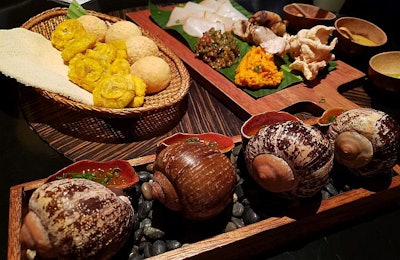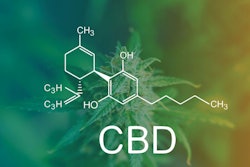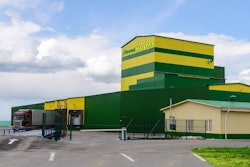
Brazilian President Jair Bolsonaro recently accused actor Leonardo DiCaprio of funding arsonists setting fire to the Amazon. Supposedly, rainforest conservation groups had torched the Amazon in a bid for sympathy, which brought in donations from environmentalist DiCaprio. No evidence exists for any of this, and it was Bolsonaro who lifted restrictions on deforestation not Hollywood A-listers. That odd bit of news reminded me of how pet food could help protect the Amazon rainforest, Alaskan tundra or other ecosystems.
This summer, while some burned their share of the Amazon, I dined on novel dishes harvested from the Peruvian portion, such as the giant snails and an even bigger fish, the 10-foot-plus paiche. The restaurant Amaz in Lima, Peru serves dishes made with plants and animals traditionally used by indigenous peoples of the Amazon. All the ingredients were caught, cultivated or cut in ways that ensure future harvests and ecological health, the waiter assured me. I assumed he was correct, so that I could enjoy my meal. I was in Peru by invitation from Kemin to speak to fishmeal producers along the Pacific Coast of South America about pet food trends related to their products.
TRANSPARENCY NOTE: Kemin, a supplier of natural antioxidants, invited me to give these presentations. Kemin advertises in Petfood Industry and is a client of WATT Global Media. Kemin paid for my travel expenses.
Chef Pedro Schiaffino wrote on Amaz’s webpage that after a trip to the Amazon, he was surprised that so many delicious edibles were confined to the Amazon and not known to the international culinary world. Likewise indigenous preparation methods and recipes were disappearing along the other traditions of the people who inhabited the forest before Iberian invasion. The ultimate goal of the restaurant is to preserve cultures and provide tangible economic reasons to maintain the rainforest.
Pet food ingredients from conservation areas
Pet food ingredient suppliers could do something similar by finding novel items sourced sustainably from the Amazon or other conservation targets. Doing so would bolster the pet food trend of formulating pet foods according to specific regions, ecosystems or biomes. Likewise, many pet owners demand that pet foods meet their ethical standards, particularly environmental and social sustainability. What could be more granola than saving the rainforest through pet food?
Easier said than done. First, Amazonian plants and animals are so novel that no feeding trials have been conducted to establish their safety. I suppose you could ask Amazonian residents if their dogs or cats ever ate the items to get some idea, but that’s hardly enough. Likewise, the Association of American Feed Control Officials hasn’t reviewed misgquipanga (a ginger-flavored leaf from Amazonia) or a thousand other exotic edibles, though one could hope the ingredients would be declared Generally Recognized As Safe (GRAS).
Many of these ingredients are produced in such small quantities that they would be difficult to secure a steady supply. The characteristics of the products likely would vary from batch to batch. Gathering items from the forest takes specials skills and time, as does low-impact agriculture. The logistics of transporting bulky, perishable agricultural products may well stifle any of the environmental benefits. However, some food producers have met these challenges, such as the aquaculture operations of Amazone raising paiche in Peru.
There’s no reason to focus only on the Amazon plenty of other ecosystems need conservation. Even my own Missouri forests produce pawpaws, persimmons and venison. Plus, I imagine there’s a few folks in the Ozarks who know the woods and would love a gig harvesting.
Developing lines of supply may be difficult at first, but can pay off if a particular ingredient becomes a foodie darling, and by extension the next hot novel pet food ingredient. Plenty of ingredients have moved from the fringe into the mainstream, such as quinoa. In Bolivia, I first ate quinoa as a side dish to an alpaca steak, while marveling at the stark whiteness of the Salar de Uyuni in 2007. Now you can buy the grain in 10-pound bags at Walmart and find quinoa in numerous pet foods.
Ensuring the ecological and social sustainability of the harvest could also be difficult. Ingredients have been touted as boons for local communities, including quinoa, only to result in economically vulnerable monoculture booms that bust, while degrading the land and cultural traditions. Similarly, without enforcement of environmental stewardship practices, overharvesting of shared resources could result in a tragedy that is all too common.
Nevertheless, putting a price tag on environmental services, including growing novel pet food ingredients, incentivizes people to protect ecosystems and keep them relatively intact. While living in Honduras as a Peace Corps volunteer, I saw this first hand in the coffee farms ringing the mountains rising over my village. Much of the old growth on the steep hills was cut long ago, as people struggled to cultivate the only soil left to them by the landholders of the valley. Erosion had become a serious problem, and soil had lost fertility. However, as coffee farmers transitioned cultivation practices to shade grown coffee, they boosted biodiversity while improving their coffee crops. The farmers planted ecosystems that provided coffee beans from the understory, bananas above that, while growing yet taller, leguminous trees fertilized the soil with their symbiotic bacteria. The canopy of these agricultural ecosystems were fruit trees or hard woods, like mahogany, which served as foliar 401ks to be cut down only once they reached maturity. These coffee farms were not at all native ecosystems. Many of the trees were non-native, but monkeys, boas and ocelots didn’t mind.
I don’t think we can save the Earth by eating it, or assigning a monetary value to every species based on its tastiness. I do think we have the capacity to create ecologically balanced food production methods, and I think we should try to make use of intact ecosystems as much as possible. Just think how cool it would be if instead of wiping out the bison (and degrading the people who depended on them), North America had a massive yearly migration of animals stretching from Canada to Mexico that met all our red meat desires. Wouldn’t it be even cooler if the people tending those bison were those who built their culture alongside them uninterrupted since time immemorial? Humanity lost that opportunity, yet there are still opportunities to forge sustainable economic alliances between ecosystems, the people who steward them and the pet food industry.


















